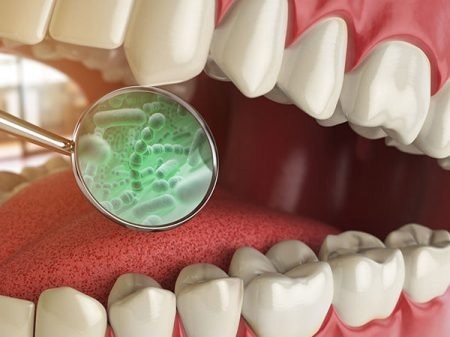Reviewed by Lexie CornerFeb 27 2024
Bacteria influence oral health in various ways, from the unpleasant condition of halitosis to the unpleasant fuzzy feeling in our teeth.
 A new chemical sensor array detects and inactivates several disease-causing dental bacteria. Image Credit: Maxx-Studio/Shutterstock.com
A new chemical sensor array detects and inactivates several disease-causing dental bacteria. Image Credit: Maxx-Studio/Shutterstock.com
Dental illnesses require diagnosis and treatment. However, figuring out which microorganisms are causing an infection can be time-consuming and costly. Recently, scientists have created an artificial tongue, or chemical sensor array, that can identify and deactivate dental bacteria. Their findings were published in ACS Applied Materials & Interfaces.
Finding the source is the first step in treating dental diseases like cavities or periodontitis caused by bacteria. Conventional techniques for detection and identification may include sophisticated equipment-based culturing or searching for particular DNA markers that belong to various species.
Thus, sensor arrays, also called electronic or artificial tongues, present a straightforward and less costly alternative that Na Lu, Zisheng Tang, and colleagues wanted to explore. Similar to how a real tongue can taste multiple flavors at once, artificial tongues developed in the past have been able to detect and measure a variety of bacteria. Additionally, the researchers aimed to incorporate the capacity to mitigate the impacts of the detected oral bacteria, also known as inactivation.
The researchers used iron oxide particles coated in DNA strands to create nanozymes, which are microscopic particles that resemble natural enzymes. The presence of nanozymes caused a colorless indicator to turn bright blue when hydrogen peroxide was added to a solution. However, the bacteria that stuck to the DNA reduced the reactivity of the nanozyme, which lessened the amount of blue color produced. To associate each type of bacteria with a distinct shift in color signals, the researchers coated nanozymes with distinct DNA strands.
The researchers generated dental bacteria samples from eleven different species to test the DNA-nanozyme system as a substitute for a tongue. The sensor array detected every type of bacteria present in synthetic saliva samples. The researchers then determined whether a dental plaque sample originated from a cavity-ridden individual or a healthy volunteer using the DNA-encoded nanozyme sensor array.
The dental bacteria species tested showed antibacterial effects from the DNA-encoded nanozyme sensor array. Three common bacterial species were rendered inactive in solutions containing the nanozyme system compared to controls lacking the nanozymes. The researchers’ analysis of electronically scanned microscopic images indicates that the nanozyme system destroyed the bacteria's membranes. They speculate that bacterial dental illnesses may one day be identified and treated using this sensor system.
The authors acknowledge funding from the National Natural Science Foundation of China, the National Key Research and Development Program of China, the Program for Professor of Special Appointment (Eastern Scholar) at Shanghai Institutions of Higher Learning, and the Municipal Science and Technology Committee of Shanghai Outstanding Academic Leaders Plan (Youth).
Journal Reference:
Zhang, L., et al. (2024) Enhanced “Electronic Tongue” for Dental Bacterial Discrimination and Elimination Based on a DNA-Encoded Nanozyme Sensor Array. ACS Applied Material Interfaces. doi.org/10.1021/acsami.3c17134